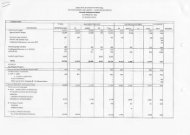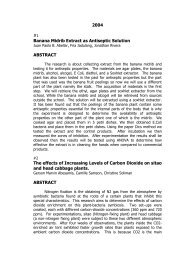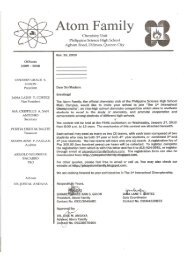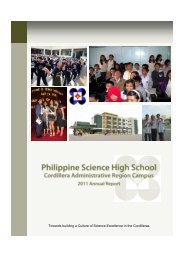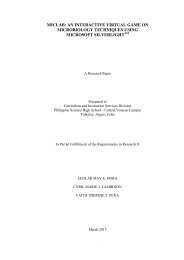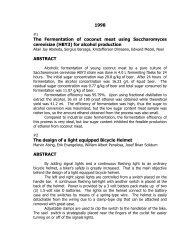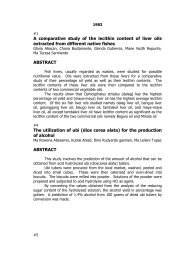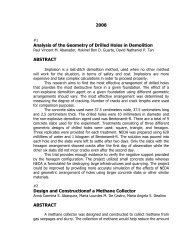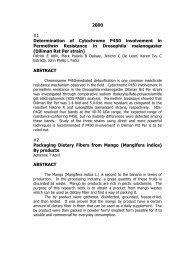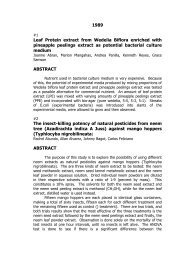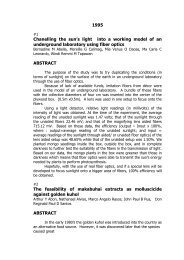(LAGUNDI) AGAINST MOSQUITO LARVAE - Central Visayas ...
(LAGUNDI) AGAINST MOSQUITO LARVAE - Central Visayas ...
(LAGUNDI) AGAINST MOSQUITO LARVAE - Central Visayas ...
You also want an ePaper? Increase the reach of your titles
YUMPU automatically turns print PDFs into web optimized ePapers that Google loves.
!<br />
LARVICIDAL ACTIVITY OF Vitex negundo Linn. (<strong>LAGUNDI</strong>)<br />
<strong>AGAINST</strong> <strong>MOSQUITO</strong> <strong>LARVAE</strong><br />
A Research Paper<br />
Presented to the<br />
Curriculum and Instruction Services Division<br />
Philippine Science High School- <strong>Central</strong> <strong>Visayas</strong> Campus<br />
Talaytay, Argao, Cebu<br />
In Partial Fulfillment of the Requirements in Research II<br />
CHESKA MARI B. GANHINHIN<br />
ARA PATRICE M. KINTANAR<br />
March 2013<br />
!
Republic of the Philippines<br />
Department of Science and Technology<br />
PHILIPPINE SCIENCE HIGH SCHOOL - CENTRAL VISAYAS CAMPUS<br />
Talaytay, Argao, Cebu<br />
CERTIFICATE OF PANEL APPROVAL<br />
The research attached hereto, entitled “LARVICIDAL ACTIVITY OF<br />
Vitex negundo Linn. (<strong>LAGUNDI</strong>) <strong>AGAINST</strong> <strong>MOSQUITO</strong> <strong>LARVAE</strong>”,<br />
prepared and submitted by CHESKA MARI B. GANHINHIN and ARA<br />
PATRICE M. KINTANAR is hereby recommended for approval.<br />
CHRISTINE MARIE T. CEBLANO<br />
Research Adviser<br />
MARY JOY I. MONCADA<br />
Panel Member<br />
REY GIOVANNI L. VILLAMORA<br />
Panel Member<br />
!<br />
___________________<br />
Date<br />
___________________<br />
Date<br />
___________________<br />
Date<br />
This research paper is approved in fulfillment of the requirements in RESEARCH II.<br />
RECOMMENDING APPROVAL:<br />
SHERRY P. RAMAYLA JOSEPH P. HORTEZUELA<br />
Unit Head, Research Unit CISD Chief<br />
APPROVED BY:<br />
FLORITA A. PONTILLAS, ED.D.<br />
Campus Director
BIOGRAPHICAL DATA<br />
Researcher : Cheska Mari Bautista Ganhinhin<br />
Age : 16 years old<br />
Address : Candau-ay, Dumaguete City, Negros Oriental<br />
Date of Birth : September 01, 1996<br />
Mother : Elenita Bautista Ganhinhin<br />
Father : Noriel Apiag Ganhinhin<br />
Siblings : Jomari Bautista Ganhinhin<br />
Contact no. : 09295482263<br />
Francis Joshua Bautista Ganhinhin<br />
Motto : No guts, no glory.<br />
Researcher : Ara Patrice Matarlo Kintanar<br />
Age : 15 years old<br />
Address : Poblacion, Argao, Cebu<br />
Date of Birth : April 01, 1997<br />
Mother : Judy Matarlo Kintanar<br />
Father : Paterno Genaro Abobo Kintanar<br />
Siblings : Ace Francis Matarlo Kintanar<br />
Contact no. : 09222503144<br />
Arce Gabriel Matarlo Kintanar<br />
Athena Judielle Matarlo Kintanar<br />
Motto : Life is a great big canvass, and you should throw all the paint on it you can.<br />
!
ACKNOWLEDGEMENT<br />
The researchers would like to acknowledge the Chemistry Department of the<br />
University of San Carlos-Talamban Campus (USC-TC), Talamban, Cebu City for<br />
allowing them to prepare the necessary solution needed in their experiment, and<br />
Philippine Science High School – <strong>Central</strong> <strong>Visayas</strong> Campus (PSHS-CVisC) for the<br />
endless support they have given.<br />
The researchers would also like to thank Ms. Sharajen Julasiri, Ms. Ligaya<br />
Suico and the staff from USC-TC Chemistry Department for their unconditional help<br />
and guidance in the conduct of their study.<br />
The researchers would also like to thank the Research II instructors including<br />
their very own adviser, Ms. Christine Marie Ceblano, and their panel members, Ms.<br />
Mary Joy Moncada and Mr. Rey Giovanni Villamora, for teaching them the concepts<br />
behind research and for sparing their time in editing and checking their research<br />
paper. They would also like to acknowledge the efforts of the PSHS Lab assistant,<br />
Mr. Paul Isaac Dizon, and for his unceasing determination in helping the researchers<br />
finish their study.<br />
The researchers would also like to recognize the support from their batchmates<br />
and serving as inspirations to finish their study.<br />
The researchers would also like to express their deepest gratitude to their<br />
parents and family, to the Ganhinhin family, Matarlo family and Kintanar family, for<br />
constantly assisting them in everything they encounter.<br />
And to Almighty God.<br />
The researchers,<br />
CHESKA MARI B. GANHINHIN ARA PATRICE M. KINTANAR<br />
!
Ganhinhin, C.M.B., and A.P.M. Kintanar. 2013. LARIVICIDAL ACTIVITY OF Vitex<br />
negundo Linn. (<strong>LAGUNDI</strong>) <strong>AGAINST</strong> <strong>MOSQUITO</strong> <strong>LARVAE</strong>. A Research Paper.<br />
Philippine Science High School – <strong>Central</strong> <strong>Visayas</strong> Campus, Talaytay, Argao, Cebu.<br />
ABSTRACT<br />
Mosquitoes have been a constant problem in the community as they<br />
continuously transmit serious diseases. Therefore, this study aimed to eliminate larvae<br />
of mosquitoes using Vitex negundo Linn. ethanol leaf extracts. This was done by<br />
comparing the span of time the larvae were exterminated upon exposure to treatments<br />
with three various ethanol leaf extract concentrations. The three concentrations of<br />
ethanol leaf extracts were 30%, 60%, and 90% with commercial insecticide as the<br />
positive control and the extracting solvent ethanol as the negative control. Three trials<br />
with three replicates with ten larvae each replicate were utilized in the study. The time<br />
(in minutes) of mortality was measured for each treatment application and the<br />
significance between the treatments was analyzed using the One-Way ANOVA and<br />
Tukey Test. Results showed a statistically significant difference between the 30%<br />
extract when compared to the 60% extract, 90% extract, positive control insecticide<br />
and control ethanol. The 60% extract, 90% extract and ethanol displayed a statistically<br />
insignificant difference when compared to the positive control. The Vitex negundo<br />
Linn. ethanol leaf extract therefore has larvicidal activity against mosquito larvae,<br />
though thorough processing is still necessary for assured efficiency.<br />
!
!<br />
TABLE OF CONTENTS<br />
Title Page<br />
TITLE PAGE i<br />
CERTIFICATE OF PANEL APPROVAL ii<br />
BIOGRAPHICAL DATA iii<br />
ACKNOWLEDGEMENT iv<br />
ABSTRACT v<br />
TABLE OF CONTENTS vi<br />
LIST OF TABLES viii<br />
LIST OF FIGURES ix<br />
CHAPTER I. INTRODUCTION<br />
1.1 The Problem and Its Background 1<br />
1.2 Objectives of the Study 3<br />
1.3 Significance of the Study 3<br />
1.4 Scope and Limitations of the Study 4<br />
1.5 Definition of Terms 4<br />
CHAPTER II. REVIEW OF RELATED LITERATURE<br />
2.1 Mosquitoes<br />
6<br />
2.1.1 Mosquitoes in the Larval Stage<br />
7<br />
2.2 Vitex negundo Linn. 7<br />
2.2.1 Studies on Vitex negundo Linn.<br />
8<br />
2.3 Pesticides and Insecticides 10<br />
2.4 Transfluthrin 11<br />
2.5 Ethanol as an Extracting Solvent 13<br />
2.6 Basic Principles of the Iodoform Test for Ethanol 14<br />
CHAPTER III. METHODOLOGY<br />
3.1 Research Design 15<br />
3.2 Mosquito Larvae Accumulation and Transfer 15<br />
3.3 Collection of Leaves 15<br />
3.4 Ethanol Leaf Extract Preparation 15<br />
3.5 Iodoform Test for Ethanol 16<br />
3.6 Treatment Application 16<br />
3.7 Analysis of Data 17<br />
CHAPTER IV. RESULTS AND DISCUSSION<br />
4.1 Iodoform Test 18<br />
4.2 Extent of Extermination Time 18<br />
4.3 Analysis of Data 19<br />
vi!
CHAPTER V. CONCLUSION AND RECOMMENDATIONS<br />
!<br />
5.1 Conclusion 21<br />
5.2 Recommendations 22<br />
BIBLIOGRAPHY 23<br />
APPENDIX<br />
Appendix A. Experimental Raw Data 28<br />
Appendix B. Photos 30<br />
vii!
!<br />
LIST OF TABLES<br />
Table Description Page<br />
1 Average Extermination Time of Adult Mosquitoes in Minutes 18<br />
2 One-Way ANOVA Results 28<br />
3 Tukey Test Results, Multiple Comparisons 28<br />
4 Extermination Time by Positive Control commercial insecticide 29<br />
5 Extermination Time by 30% Ethanol Leaf Extract 29<br />
6 Extermination Time by 60% Ethanol Leaf Extract 29<br />
7 Extermination Time by 90% Ethanol Leaf Extract 29<br />
8 Extermination Time by Control Ethanol 29<br />
viii!
!<br />
!<br />
!<br />
LIST OF FIGURES<br />
Figure Description Page<br />
1 The chemical reaction involved in the Iodoform reaction<br />
when initiated from a primary alcohol (ethanol).<br />
2 Average Time of Extermination vs. Applied Treatments graph 20<br />
3 Vitex negundo Linn. plant 30<br />
4 Rotary Evaporator 30<br />
5 Mosquito larvae in stagnant water. 30<br />
6 (A) The larvae after treatment of Positive Control<br />
Commercial Insecticide, P. (B) The larvae after treatment of<br />
Control Ethanol, C.<br />
7 (A) The larvae after treatment of 30% Ethanol Leaf Extract, E30.<br />
(B) The larvae after treatment of 60% Ethanol Leaf Extract, E60.<br />
(C) The larvae after treatment of 90% Ethanol Leaf Extract, E90.<br />
8 Observation of Subject Organisms. This was done using a box<br />
with wood as support and screen as the walls. A light source<br />
was placed inside the box and petri plates were placed on top<br />
of the screen.<br />
9 The ethanolic leaf extracts after performing the Iodoform Test<br />
for Ethanol. The absence of the yellow precipitate indicated<br />
the absence of ethanol.<br />
ix!<br />
14<br />
31<br />
31<br />
32<br />
32
1.1 The Problem and its Background<br />
CHAPTER I<br />
INTRODUCTION<br />
Mosquitoes are one of the most medically significant transmitters as they<br />
spread parasites and pathogens, which continue to have devastating effects on human<br />
beings (Maheswaran et al., 2008). Mosquito-borne diseases such as malaria, filariasis,<br />
yellow fever and dengue cause extensive morbidity and mortality and are a major<br />
economic burden within disease-endemic countries (Sachs and Malaney, 2002;<br />
Boutayeb, 2006). Every year, about 300 million people are estimated to be affected by<br />
malaria, a major killer disease, which threatens 2,400 million (about 40%) of the<br />
world’s population (Sharma, 1999; Snow et al., 2005). Similarly, lymphatic filariasis<br />
caused by Wuchereria bancrofti affects about 106 million people worldwide. About<br />
20 million people are infected every year by dengue viruses transmitted by Aedes<br />
mosquitoes with about 24,000 deaths (Poopathi et al., 2010).<br />
Current control is based on the use of commercial insecticides which have<br />
potential toxic effect on public health and the environment. Synthetic insecticides<br />
have been used during the past several decades to control varied dipteran pests<br />
(Poopathi et al., 2010). Pesticides are indeed very effective in its use. But along with<br />
their useful effects, they also bring out serious harm to human health as well.<br />
Furthermore, these chemicals are expensive and are often toxic to both human and<br />
other animals and natural enemies (Cartilla and Dela Cruz, 2012). The intensive use<br />
of chemical insecticides led to the development of resistant insect populations,<br />
resulting in a reduced control and often to a negative impact on various non-target<br />
organisms and on the environment in general (Charles and Nielsen-LeRoux, 2000).<br />
1
However, the use of chemical insecticides has been greatly impeded due to<br />
development of physiological resistance in the insect intermediaries, environmental<br />
pollution resulting in bio-amplification of food chain contamination and harmful<br />
effects on beneficial non-target animals. In recent years, the increasing information on<br />
hazardous effect of synthetic insecticides on plant and animal health has alarmed<br />
scientists to seek some alternative ways such as insecticides which are eco-friendly<br />
(Montasser, 2011). Therefore, the need for alternate, more effective and environment-<br />
friendly control agents or insecticides became urgent (Poopathi et al., 2010).<br />
Botanical insecticides are one of the best alternatives for these hazardous<br />
chemicals. They are plant–drive insecticides which are either naturally occurring plant<br />
materials or the products simply derived from such plants such as Vitex negundo Linn.<br />
(Gupta et al., 2005).<br />
Vitex negundo Linn. or lagundi is credited with innumerable medicinal<br />
activities like analgesic, anti-inflammatory, anticonvulsant, antioxidant, bronchial<br />
relaxant and hepatoprotective. The plant products of Vitex negundo (lagundi) are<br />
variously reported to possess insecticidal ability against stored-product pests, i.e.<br />
pantry pests include several beetles, moths, and a mite that can infest whole grains or<br />
processed foods, pests, houseflies, and tobacco leaf eating larvae. Leaf oil of the plant<br />
is shown to have repellent action against stored product pests (Tandon, 2005).<br />
Therefore, it was settled to ascertain the larvicidal ability of Vitex negundo Linn.<br />
(lagundi) against adult mosquitoes.<br />
2
1.2 Objectives of the Study<br />
The main objective of the study was to test the larvicidal ability of Vitex<br />
negundo Linn. (lagundi) leaf extracts against mosquito larvae.<br />
Specifically, the research aimed to:<br />
a. determine the average time the mosquito larvae were exterminated when<br />
exposed to the following treatments: the positive control which is<br />
commercial insecticide, the control ethanol, and the leaf extracts with<br />
concentrations of 30%, 60%, and 90% Vitex negundo Linn.; and,<br />
b. compare the span of time the mosquito larvae were exterminated when<br />
exposed to the abovementioned treatments using One-Way ANOVA and<br />
Tukey Test.<br />
1.3 Significance of the Study<br />
Vitex negundo Linn. (lagundi) is considered as a medicinally significant plant.<br />
The further results of this study could add up to lagundi’s reputation and importance,<br />
which will therefore invoke people to preserve and further utilize the plant species.<br />
The results would also contribute to the insecticide industry as it helps find a cheaper,<br />
more acquirable, eco-friendly and effective alternative for their products. This would<br />
also benefit consumers and the populace to eliminate mosquitoes in their locality.<br />
Along with the control of mosquitoes, there is thus the decline in health issues and<br />
diseases which they transmit. This would also eradicate the mosquitoes before they<br />
could transmit the diseases that they carry. The study could also endorse and promote<br />
further queries and studies concerning the pest management of mosquitoes and other<br />
beneficial uses of Vitex negundo Linn.<br />
3
1.4 Scope and Limitations of the Study<br />
The study is limited on determining the larvicidal ability of Vitex negundo<br />
Linn. leaf extracts against mosquito larvae. The said extracts were collected from the<br />
leaves of the said plant species. The study only involved the mosquitoes at the larval<br />
stage, and does not include those of the egg, pupal and adult stage. The age or instar<br />
of the larvae will not be determined in the study. The species of the mosquito larvae<br />
will not be considered. The study is also limited to the procedure involving three<br />
treatments compared to a positive control which is a commercially available<br />
insecticide and control which is ethanol. The solvent used will only be limited to 95%<br />
ethanol. The concentration of said treatments will be 30%, 60% and 90% Vitex<br />
negundo Linn. leaf extracts. Bioactive compounds and components explaining the<br />
termination of adult mosquitoes will not be determined in the study.<br />
Furthermore, the effect of said treatments will also be verified using the span<br />
of time the mosquito larvae were exterminated after the applications of these<br />
treatments only. Only three trials with three replicates each trial are utilized with ten<br />
larvae per replicate. The treatments which are able to eliminate mosquito larvae are<br />
the ones to be included in the statistical analysis.<br />
1.5 Definition of Terms<br />
ANOVA – Analysis of Variance; it is a statistical method for<br />
making simultaneous comparisons between two or more<br />
means and yields values that can be tested to determine<br />
whether a significant relation exists between variables.<br />
Extermination - implies complete and immediate extinction by killing<br />
off all individuals.<br />
Ethanol – a colorless volatile flammable liquid C2H5OH that is the<br />
intoxicating agent in liquors and is also used as a<br />
solvent and in fuel.<br />
4
Insecticide – a substance used for killing insects; the chemical used<br />
for extermination.<br />
Iodoform Test – a chemical color test for the presence of a R(CO)CH3<br />
functionality by treatment with aqueous base and<br />
iodine, evidenced by the formation of a yellow<br />
precipitate of CHI3.<br />
Lagundi – (scientific name: Vitex negundo Linn.) is a large native<br />
shrub that is indigenous in the Philippines and has been<br />
traditionally used as herbal medicine.<br />
Larvicide – an agent that kills insect larvae.<br />
Pesticide – a substance used for destroying insects or other<br />
organisms harmful to cultivated plants or to animals; the<br />
agents identified to exterminate pests.<br />
Positive Control – an experimental sample whose result is already known<br />
to be positive; it is used to check for errors during the<br />
procedure. In this case, the positive control will be<br />
commercial insecticide.<br />
Rotary evaporator – a piece of apparatus consisting of a motor unit that<br />
rotates the evaporation flask, a vacuum system, a heated<br />
water bath and a condenser, which is used to remove<br />
solvents from samples under reduced pressure.<br />
Transfluthrin – is one of the best-tested insecticidal agents, and has<br />
been incorporated in products against flying insects. In<br />
regard to its structure, toxicology and principle of action<br />
on insects' nerves, Transfluthrin is regarded as one of<br />
the fast-acting pyrethroids with low persistency.<br />
Tukey Test – a method that is used to determine which groups among<br />
the sample have significant differences. A post-hoc test<br />
is needed after we complete an ANOVA in order to<br />
determine which groups differ from each other.<br />
5
2.1 Mosquitoes<br />
CHAPTER II<br />
REVIEW OF RELATED LITERATURE<br />
Mosquitoes are flying, biting insects that develop in water during their<br />
immature stages. Mosquitoes have four life stages: the egg, larva, pupa, and adult.<br />
Eggs are laid on the surface of water (Culex and Anopheles types) or damp soil that is<br />
soon to flood (Aedes type). Most eggs hatch within 48 hours. The larvae live in water<br />
and breathe at the surface through tubes. Larvae, or wrigglers, feed on organic debris<br />
and microorganisms in the water, then molt into pupae, a resting stage that remains in<br />
the water. During this time the mosquito develops into an adult. After two days, the<br />
pupal skin splits and the adult emerges. The length of this life cycle varies by species<br />
from 4-30 days (Cornell Cooperative Extension, 2012).<br />
Mosquitoes bites are itchy since when a certain mosquito bites, it injects<br />
chemicals to prevent the blood from clotting and reduce pain. These chemicals cause<br />
irritation. Mosquitoes are attracted by CO2 (Carbon dioxide) in our breath. They can<br />
detect this from great distances. When the female mosquito gets close, she makes a<br />
final choice using skin temperature, odor and other chemical or visual factors.<br />
Mosquito larvae eat organic material, bacteria and microscopic plants and animals<br />
found in water. Pupae do not feed (Alameda County Mosquito Abatement District,<br />
2000).<br />
Mosquitoes spread disease to humans, domestic animals, and wildlife.<br />
Emergent mosquito-borne diseases, such as dengue fever and West Nile virus<br />
(WNV), are recognized as an imminent health risk for people (Hawaii Conservation<br />
Alliance, 2005).<br />
6
2.1.1 Mosquitoes in the Larval Stage<br />
The second life stage of a mosquito is the larva. Larvae always live in water<br />
and cannot survive long out of it. The larva is an active stage that feeds while floating<br />
at the water surface. They get air at the water surface through a snorkel-like device.<br />
When disturbed, larvae actively move in an s-shape motion which gives them their<br />
common name "wriggler." They can swim down from the surface but need to return<br />
to it shortly in order to breathe. Larvae are filter feeders, eating organic matter in the<br />
water, which they collect by using their bristle-like mouthparts.<br />
Current control is based on removing the standing water in which the larvae<br />
have hatched. If removing the stagnant water is not possible, people may be able to<br />
treat it with an insecticide or with oil that covers the surface (Caron, 1996).<br />
2.2 Vitex negundo Linn. (Lagundi)<br />
Vitex negundo Linn. (lagundi) is a large aromatic shrub or sometimes a smaller<br />
slender tree with quadrangular, densely whitish tomentose branchlets up to 4.5-5.5<br />
meters in height. The plant is used in a variety of means throughout its distribution<br />
points as an astringent, cephalic, stomachic, antiseptic, alterant, thermogenic,<br />
depurative, rejuvenating, ophthalmic, anti-gonnorhoeic, anti-inflammatory, antipyretic<br />
and useful in bronchitis, asthma, and the enlargement of the spleen. Its roots are<br />
primarily used as a tonic, febrifuge, antirheumatic, diuretic, expectorant, and are<br />
useful as a demulcent in dysentery, in cephalalgia, otalgia, colic, uropathy, wound and<br />
ulcers. The bark is also useful in odontalgia, verminosis and opthalmopathy. The<br />
flowers are mainly used as an astringent, carminative, hepatoprotective, digestive and<br />
are useful in hemorrhages and cardiac disorders. The leaves are chiefly utilized as<br />
astringents, anodyne, anti-inflammatory, antipyretic or febrifuge, tranquilizer,<br />
bronchial smooth muscle relaxant, anti-arthritic, antihelmintic and vermifuge. The<br />
7
leaves (leaf oil) are also reported to have repellent action against stored product pests<br />
(Tandon, 2005).<br />
Vitex negundo Linn. is a large aromatic shrub or small slender tree of about 3<br />
meters in height with quadrangular branches. It is mostly found in moist areas,<br />
scattered all throughout Mediterranean countries and <strong>Central</strong> Asia. It is a plant of the<br />
Verbenaceae family and is commonly known as five leaved chaste tree. The plant is<br />
found throughout India, Ceylon- Afghanistan, tropical Africa, Madagascar, China and<br />
Philippines (Kirtikar and Basu, 2008). The plant occurs in Bengal, Southern India and<br />
Burma also (Nadkarni, 2002). It is common in waste places around villages, river<br />
banks, moist localities and in the deciduous forests (Sharma et al., 2005).<br />
2.2.1 Studies on Vitex negundo Linn. (Lagundi)<br />
Vitex negundo Linn. has been reported to have various advantageous uses, and<br />
therefore, this has pushed scientists and researchers to test and further explore the<br />
capabilities of this plant.<br />
Anti-cancer potential was tested by Diaz et al. (2003), on the cytotoxicity of<br />
flavones isolated from the chloroform extract of Vitex negundo leaves. Vitexicarpin, a<br />
flavone was investigated for its cytotoxic action in human cancer cell line.<br />
Antimicrobial capabilities were also evaluated. Rideout et al. (1999) reported<br />
antibacterial & antifungal activity of Vitexilactone & Casticin from the chloroform<br />
extract of Vitex negundo leaves against Staphylococcus aureus, Pseudomonas<br />
aeruginosa, Candida albicans and Aspergillus niger using agar plate method.<br />
Alagarsamy et al. (1999) reported antibacterial & antifungal activity of Vitex negundo<br />
leaves. Antibacterial & antifungal activity of chloroform, methanol and water extracts<br />
were evaluated by Agar cup plate method at concentrations of 10 mg/ml, 20 mg/ml<br />
and 30 mg/ml against E.coli, P. aeruginosa, S. aureus & Candida albicans<br />
8
employing co-trimoxazole & amphotericin as a reference standards for said<br />
screenings. Rana & Dayal (2003) and Kaushik et al. (2003) reported anti-microbial<br />
activity of hexane and methanolic extracts of Vitex negundo leaves. The extracts were<br />
active against Mycogene perniciosa, Rhizoctonia solani, Bacillus megaterium,<br />
Pseudomonasa fluorescens, Staphylococcus species and Xanthomonas species. Shin<br />
et al. (1997), Lee et al. (1998) & Iqbal et al. (2002) & Nyligira et al. (2004)<br />
reported anti-microbial activity from the chloroform extract of Vitex negundo leaves<br />
containing Vitexilactone and Casticin and were active against Candida albicans,<br />
Aspergillus niger, Fusarium chlamdosporum, Staphylococcus aureus and<br />
Pseudomonas aeruginosa. Loganathan et al. (2004) investigated antibacterial activity<br />
from the methanolic and chloroform extracts of Vitex negundo leaves against<br />
Staphylococcus aureus, Staphylococcus epidermidis, Staphylococcus albus, Bacillus<br />
subtilis, Escherichia coli, Klabsiella aerogens, Proteus vulgaris and Pseudomonas<br />
aeruginosa using Agar Plate Method. Singh et al. (2010) reported antibacterial and<br />
antifungal activity of volatile oil against S. aureus, E. coli, K. pneumoniae, B. subtilis,<br />
M. luteus and Candida albicans using ciprofloxacin and chloramphinicol as<br />
reference.<br />
Chawla et al. (1992) investigated anti-inflammatory activity of chloroform<br />
extract of seeds of Vitex negundo in Sprague-Dawley male rats in carrageenan<br />
induced rat paw edema using Ibuprofen as standard drug. Rao et al. (1977), Ahmad et<br />
al. (1989), Chawla et al. (1991), & Nyligira et al. (2004) reported anti-inflammatory<br />
activity of bark, seeds, seed oil and essential oil of Vitex negundo. Jana et al. (1999)<br />
reported preliminary anti-inflammatory activity of Vitex negundo in albino rats along<br />
with Zingiber officianale and Tinospora cordifolia. Dharmasiri et al. (2003)<br />
investigated anti-inflammatory activity from the aqueous extract of Vitex negundo<br />
9
leaves in Wistar rats (male) using carrageenan-induced & formaldehyde-induced rat<br />
paw oedema using indomethacin as standard. The early phase of carrageenan-induced<br />
rat paw oedema was significantly suppressed in an inversely dose-dependent manner.<br />
Immuno-stimulant Activity was also assessed. Singh et al. (2005) reported<br />
immunostimulatory activity from the extracts of Vitex negundo in oxyburst<br />
phagocytic assay using human polymorph nuclear cells. Suri et al. reported<br />
immunostimulatory potential of two iridoid glucosoides from Vitex negundo leaves.<br />
Zheng et al. (1999), Zheng and Luo (1999) and Onu et al. (2004) reported<br />
antioxidant potential of Vitedoin A, Vitedoin B and other lignans derivatives from<br />
the seeds of Vitex negundo. Tondon & Gupta (2005) reported anti-oxidant effect of<br />
Vitexin which is a new compound. Tiwari & Tripathi (2007) evaluated antioxidant<br />
property of different fractions of Vitex negundo by employing various invitro systems,<br />
such as 2, 2’-azino-bis-3-ethyl benzothiazioline-6-sulfuric acid (ABTS), Lipid<br />
peroxides (LPO), Superoxide, Hydroxyl radical scavenging and iron chelation. Total<br />
antioxidant capacity was determined by the assay based on the performed radical<br />
monocation ABTS. LPO was assessed in terms of thiobarbituric acid reactive<br />
substances by using egg yolk homogenates as lipid rich media.<br />
Amancharla et al. (1999) also tested mosquito repellent activity of aqueous<br />
extract of Vitex negundo leaves. A new chemical ‘rotundial’ was tested for the said<br />
activity. The chloroform fraction of the aqueous extract of the fresh leaves of Vitex<br />
negundo by bioactivity guided isolation yielded a pure compound rotundial which has<br />
shown mosquito repellent activity.<br />
2.3 Pesticides and Insecticides<br />
Pesticides have numerous beneficial effects. These include crop protection,<br />
preservation of food and materials and prevention of vector-borne diseases. For<br />
10
example pesticides may be used in the prevention of malaria, which kills up to one<br />
million children per year, and for preventing other vector-borne diseases such as<br />
dengue, leishmaniasis and Japanese encephalitis (National Resource Council, 1993).<br />
But, pesticides are toxic by design – they are designed to kill, reduce or repel<br />
insects, weeds, rodents, fungi or other organisms that can threaten public health and<br />
the economy. Their mode of action is by targeting systems or enzymes in the pests<br />
which may be identical or very similar to systems or enzymes in human beings and<br />
therefore, they pose risks to human health and the environment (National Resource<br />
Council, 1993).<br />
Pesticides are ubiquitous in the environment and most are synthetic. There is<br />
growing concern about children's exposure to pesticides and their special<br />
susceptibility. Children are not little adults, and may have higher exposures and<br />
greater vulnerability at both high and low levels of exposure (National Resource<br />
Council, 1993).<br />
An insecticide is simply a specialized type of pesticide used to kill insects. So<br />
all insecticides are pesticides and some pesticides are insecticides. Insecticides also<br />
range from industrial to ones designated for home use. There are even insecticides<br />
used to kill specific insects, like cockroaches or wasps (Organic and Chemical<br />
Pesticides, 2009).<br />
The types of insecticides available in the market range from organochlorines<br />
organophosphates, carbamate esters, pyrethroids and botanical insecticides (Squibb,<br />
2002).<br />
2.4 Transfluthrin<br />
Transfluthrin is the active ingredient in most of the commercial insecticides<br />
readily available in the market today (Baygon Agents, 2013). Transfluthrin is a fast<br />
11
acting insecticide. It is used in household and hygiene products, mainly against flying<br />
insects, such as mosquitoes and flies, but also against material pests, such as moths.<br />
Transfluthrin is one of the best-tested insecticidal agents, and has been incorporated in<br />
commercial products against flying insects since 1996. In regard to its structure,<br />
toxicology and principle of action on insects' nerves, Transfluthrin is regarded as one<br />
of the fast-acting pyrethroids with low persistency.<br />
Transfluthrin is highly selective. Low quantities are exceptionally powerful<br />
against hygiene, health and material pests in the indoor environment. The excellent<br />
knock-down action of Transfluthrin at an extremely low concentration permits its use<br />
especially in products to combat flies, mosquitoes and cockroaches. In products<br />
against crawling insects. Transfluthrin shows a flushing and knock-down effect. It is a<br />
relatively volatile substance and acts principally as a contact and inhalation agent<br />
(Baygon Agents, 2013).<br />
The mechanism of action is through inhalation and contact; broad spectrum,<br />
effects insects presynaptic voltage gate sodium channels in nerve membranesrapid<br />
causing knockdown (AERU, 2012).<br />
Unlike most of other synthetic pyrethroids, Transfluthrin is extraordinarily<br />
effective at very low application rates. Moreover, its evaporation rate proves to be<br />
particularly high, allowing the substance to evaporate even at room temperature, thus<br />
making it suitable to be applied both through heated and unheated systems. Owing to<br />
all of these features, Transfluthrin is the active choice and is applied in innovative<br />
aerosols, vaporizers (COILS, MATs, LEDs, unheated systems) and clothes-moth<br />
control products (Endura, 2000).<br />
However, Transfluthrin has caused widespread worry due to its disadvantages.<br />
One major concern is the fetal exposure to environmental toxins & infant outcome,<br />
12
and the effect of Transfluthrin to pregnant women is being studied. Studies using rat<br />
hepatocytes showed that Transfluthrin acts as a weak promotor of cell proliferation.<br />
Genotoxically, exposure to Transfluthrin has a genotoxic effect on the epithelial cells<br />
of human nasal mucosa (Fluoride Action Network Pesticide Project, 2012).<br />
Environmental toxicity tests showed that Transfluthrin is of low toxicity to algae,<br />
earthworms and birds but is highly toxic to fish and daphnia (UN, 2003). It has also<br />
been known to cause skin and eye irritation (AERU, 2012).<br />
2.5 Ethanol as Extracting Solvent<br />
Ethanol (ethyl alcohol, grain alcohol) is a clear, colorless liquid with a<br />
characteristic, agreeable odor. In dilute aqueous solution, it has a somewhat sweet<br />
flavor, but in more concentrated solutions it has a burning taste. Ethanol, CH3CH2OH,<br />
is an alcohol, a group of chemical compounds whose molecules contain a hydroxyl<br />
group, –OH - , bonded to a carbon atom.<br />
Ethanol extraction is a type of solvent extraction used to extract fragrant<br />
compounds directly from organic solvent extraction or expression. Ethanol extracts<br />
from dry materials are called tinctures, while ethanol washes for purifying oils and<br />
concretes are called absolutes. The impure substances or oils are mixed with ethanol<br />
which is less hydrophobic than solvents used for organic extraction, dissolves more of<br />
the oxidized aromatic constituents, leaving behind the wax, fats and other generally<br />
hydrophobic substances. The alcohol is evaporated under low-pressure leaving behind<br />
absolute. The absolute may be further processed to remove any impurities that are still<br />
present from the solvent extraction. Ethanol extraction is not used to extract fragrance<br />
from fresh plant materials; these contain large quantities of water which would also be<br />
extracted into the ethanol (http://oilganic.com, 2010).<br />
13
2.6 Basic Principles of the Iodoform Test for Ethanol<br />
The Iodoform Test is a chemical reaction that involves the production of<br />
iodoform (CHI3) by the multiple halogen of a methyl ketone in the presence of a base.<br />
In analytical chemistry, this reaction was traditionally used to determine the presence<br />
of a methyl ketone, or a secondary alcohol oxidizable to a methyl ketone through the<br />
iodoform test (Nuffield Foundation, 2011). This reaction is illustrated in Figure 1:<br />
Figure 1. The chemical reaction involved in the Iodoform reaction when initiated<br />
from a primary alcohol (ethanol).<br />
The iodoform test or iodoform reaction is a qualitative chemical test for the<br />
detection of ketones carrying an alpha methyl group. The reagents are iodine and<br />
sodium hydroxide. Iodoform or triiodomethane is a pale yellow substance with a<br />
relatively high molar mass due to the iodine atoms. It is therefore solid at room<br />
temperature. It is insoluble in water and has an antiseptic smell. A visible precipitate<br />
of this compound will form upon reaction with ethanol (Iodoform Reaction, 2012).<br />
14
3.1 Research Design<br />
CHAPTER III<br />
METHODOLOGY<br />
The research study was experimental and conducted so as to determine the<br />
larvicidal potential of Vitex negundo Linn. (lagundi). Three various ethanol leaf<br />
extracts were used, classified according to their concentrations: 30%, 60%, and 90%<br />
Vitex negundo Linn. leaf extract solutions. These solutions were extracted using<br />
ethanol, an organic solvent. The assigned positive control was the commercial<br />
insecticide as well as ethanol for the control. Three trials with three replicates with ten<br />
mosquito larvae placed in each replicate were exposed to the said treatments.<br />
3.2 Mosquito Larvae Collection<br />
Mosquito larvae were acquired from containers with stagnant water. The<br />
larvae acquired were carefully transferred to small plastic cups and allowed to<br />
acclimatize for two minutes to prevent stressing the larvae. The larvae were then<br />
exposed to the treatments and transferred to a petri dish and held against the light for<br />
accurate viewing of larvicidal activity.<br />
3.3 Collection of Leaves<br />
Fresh, unsullied leaves of Vitex negundo Linn. (lagundi) were collected and<br />
used for the tests. The leaves which have withered, have dust and dirt particles, and<br />
have insect bites were discarded. The accumulated leaves were rinsed and washed by<br />
running water.<br />
3.4 Ethanol Leaf Extract Preparation<br />
The collected leaf samples were oven-dried for four days until brittle and fully<br />
dried. Thereafter, the leaves were sliced and cut into small portions and homogenized<br />
15
in a blender. Four hundred seventy-six grams of the homogenized leaves were then<br />
soaked in approximately 1,200 mL 95% ethanol for 48 hours, accompanied with<br />
occasional shaking. The shaking causes the ethanol to cover the leaf samples inside<br />
the container. The ratio between the Vitex negundo Linn. leaves and the ethanol<br />
solvent did not matter as long as the ethanol solvent would overlap and fully obscure<br />
and cover the lagundi leaves. Filter paper was used to separate and filter the slurry<br />
from the solution. The ethanol left in the solution was then evaporated by means of<br />
the Rotary Evaporation Method.<br />
3.5 Iodoform Test for Ethanol<br />
The Iodoform Test for Ethanol was conducted to test the presence of ethanol<br />
in the extract, and was done by adding ten drops of 1 M NaOH and 25 drops of 0.5 M<br />
iodine solution to ten drops of the ethanol extract.<br />
A visible yellow precipitate would indicate presence of ethanol in the sample,<br />
while no precipitation formation would confirm its absence.<br />
3.6 Treatment Application<br />
The concentrations were then constituted: 3 mL of the ethanol extract was<br />
added to 7 mL of the larvae water to obtain the 30% concentration, 6 mL of the<br />
ethanol extract was added to 4 mL of the larvae water to obtain 60% concentration,<br />
and 9 mL ethanol extract was added to 1 mL of larvae water to obtain the 90%<br />
concentration. The span of time (in minutes) at which the mosquitoes were<br />
exterminated became the basis for the larvicidal potential of Vitex negundo Linn. All<br />
glasswares used in the experiment were properly washed and rinsed with distilled<br />
water.<br />
16
3.7 Analysis of Acquired Data<br />
The One-Way ANOVA was used for the interpretation of the data to ascertain<br />
if prominent differences occur in the span of time the mosquito larva were<br />
exterminated between the five applied treatments: the positive control commercial<br />
insecticide, the control ethanol, the 30%, 60% and 90% ethanol leaf extract<br />
concentrations. The Tukey Test was also used to compare the extermination time<br />
among the treatments which displayed mortality in the subject organisms (mosquito<br />
larvae) and which among the treatments possessed the highest insecticidal activity<br />
against mosquito larvae. Statistical Package for the Social Sciences (SPSS) was used<br />
to calculate the statistical data.<br />
17
4.1 Iodoform Test<br />
CHAPTER IV<br />
RESULTS AND DISCUSSION<br />
A yellow precipitate of the compound iodoform will form from a sample upon<br />
reaction with ethanol. Upon performing the Iodoform Test, no yellow precipitate<br />
formed implying an absence of ethanol from the Vitex negundo Linn. leaf extract.<br />
4.2 Extent of Extermination Time<br />
Following the application of the five treatments, the length of time in which<br />
the adult mosquitoes were exterminated was recorded. The various corresponding<br />
time interval for each trial per treatments after application were averaged and are<br />
presented in Table 1.<br />
Table 1. Average Extermination Time of Adult Mosquitoes in Minutes<br />
Treatment<br />
Positive<br />
Control, P<br />
(in minutes)<br />
30% ethanol<br />
extract, E30<br />
(in minutes)<br />
60 % ethanol<br />
extract, E60<br />
(in minutes)<br />
90% ethanol<br />
extract, E90<br />
(in minutes)<br />
18<br />
Control,<br />
C<br />
(in minutes)<br />
Trial 1 1.65 25.18 7.56 3.92 3.71<br />
Trial 2 1.27 12.31 7.81 4.37 4.30<br />
Trial 3 0.99 15.62 7.13 3.75 3.00<br />
Average 1.30 17.70 7.50 4.02 3.67<br />
*depicts the results taken after 24-hour observation after application<br />
Average extermination time results showed that commercial insecticide, the<br />
positive control, yielded the lowest time extent with a total average of 1.30 minutes in<br />
comparison to the ethanol leaf extracts. The least concentrated ethanol extract, the<br />
30% ethanol leaf extract, reflected the highest time interval with an average of 17.70<br />
minutes. The 60% ethanol leaf extract procured an average of 7.50 minutes, and the
90% ethanol leaf extract obtained an average of 4.02 minutes. The 90% ethanol leaf<br />
extract acquired the lowest average time length among the three ethanol leaf extracts,<br />
and therefore the second lowest time interval for all the five treatments. Ethanol, the<br />
control, obtained a total average time of 3.67 minutes.<br />
4.3 Data Analysis<br />
Established by the data acquired in the study, the 30% ethanol leaf extract<br />
displayed the longest extermination time. The positive control displayed the shortest<br />
extermination time, followed by the control ethanol, the 90% ethanol leaf extract and<br />
the 60% ethanol leaf extract (Table 1) respectively. Although the extermination time<br />
differed, there was a statistically significant difference between the commercial<br />
insecticide and the 30% ethanol leaf extract. The mean difference is significant at 0.05<br />
level. Any Sig. value below the 0.05 level is considered as a statistically significant<br />
difference. The One-Way ANOVA resulted in a Sig. value of 0.000 implying that<br />
there was a generally significant difference in comparison to each other (Table 2 in<br />
Appendix A). The Tukey Test for comparison of Sig. values showed that the 30%<br />
extract had a statistically significant difference when compared to the commercial<br />
insecticide while the 60% extract, 90% extract, and the ethanol displayed a<br />
statistically insignificant difference in comparison with the commercial insecticide<br />
(Table 3 in Appendix A).<br />
The average extermination time for the mosquito larvae to be eliminated upon<br />
exposure to each treatment was shown graphically (see Figure 2). The graph showed<br />
that as the concentration of the extract increases, the span of time for extermination<br />
decreases.<br />
19
!<br />
Figure 2. Average Time of Extermination vs. Applied Treatments graph<br />
Factors considered as the cause of the potential of Vitex negundo Linn.<br />
ethanolic extracts are the phytochemicals and bioactive compounds or components<br />
present in the leaf extracts. A study on the preliminary phytochemical screening of<br />
both petroleum ether and methanolic extract of Vitex negundo Linn. done by Murthy<br />
et al. (2010), revealed the presence of tannins, flavonoids, flavones and coumarins.<br />
Tannins are proved to have feed-constraining assets against larvae of insects by the<br />
study of Cardinal-Aucoin et al. (2009). A study by Morimoto et al. (2000), showed<br />
that flavonoids have antifeedant properties on exposure to particular insects. Various<br />
studies on coumarin have reflected that coumarin exhibited strong insecticidal ability,<br />
and caused high percentage of mortality on eggs and larva of insects (Reda and El-<br />
Banhewy, 1986, Sharma et al., 2006). Furthermore, a bioassay done by Romanelli et<br />
al. (2010) proved that flavones have moderate insecticidal activity.<br />
20
5.1 Conclusion<br />
CHAPTER V<br />
CONCLUSION AND RECOMMENDATIONS<br />
To compare the span of time the mosquito larvae were exterminated upon<br />
exposure to the treatments, the average time of extermination of each treatment was<br />
determined. The average extermination time for the ethanol leaf extracts with<br />
different concentrations 30%, 60% and 90% were 17.70, 7.50 and 4.02 minutes,<br />
respectively. For the positive control, the average time interval recorded was 1.30<br />
minutes. The control ethanol obtained an average time of 3.67 minutes. As shown in<br />
the Tukey Test results, only the Significant value of the insecticide and 30% extract<br />
showed a significant difference between each other. The 60% extract, 90% extract and<br />
the control ethanol displayed a statistically insignificant difference compared to the<br />
commercial insecticide.<br />
The data gathered in the study helped establish the larvicidal potential of Vitex<br />
Negundo Linn. (lagundi) against mosquito larvae. Average Extermination Time<br />
results indicate that among the ethanol leaf extracts, the 90% ethanol leaf extract held<br />
the lowest and therefore fastest time extent of death and mortality in direct<br />
comparison to the 30% and 60% ethanol leaf extracts. It is also concluded that the<br />
time span of extermination is inversely proportional to the concentration of the<br />
ethanol treatments. The 90% extract, however, does not surpass the capacity of<br />
extermination by the positive control as well as the control ethanol, both with the<br />
lowest extermination time among all the five applied treatments, although their time<br />
extent of mortality was close.<br />
In totality, the data collected show that Vitex negundo Linn. indeed has<br />
larvicidal potential when treated to larvae in high concentrations, and can be used as a<br />
21
substitute for commercial insecticides, though proper processing is still needed to<br />
ensure its appropriateness as substitute.<br />
5.2 Recommendations<br />
For future studies on the larvicidal potential of Vitex negundo Linn. (lagundi),<br />
it is therefore recommended to use other commercial insecticides as positive control<br />
to further ascertain if Vitex negundo Linn. can indeed be used as alternative for these<br />
pesticides. The application of other types of solvents is also recommended in leaf<br />
extraction to contrast its efficacy with the ethanol leaf extracts, such as methanol, is<br />
also highly endorsed. The determination of the age or instars of the larvae are also<br />
recommended. The detection of the specific bioactive compounds found in the plants<br />
which are responsible for the mortality of the adult mosquitoes is also recommended.<br />
The testing and application of the ethanol leaf extracts to other pests, such as ants or<br />
termites, so as to ascertain if these treatments have noteworthy effects on said pests<br />
would also be of help to gather more information pertaining to the study and further<br />
studies to be conducted.<br />
22
BIBLIOGRAPHY<br />
AERU. From http://sitem.herts.ac.uk/aeru/projects/ppdb/index.htm<br />
Ahmad, M.B.; Rauf, A.; Osman, S.M. 1989. Physico-chemical analysis of seven seeds<br />
oils. Journal of the oil technologist’s Association of India. 21(3): 15-21.<br />
ALAMEDA COUNTRY <strong>MOSQUITO</strong> ABATEMENT DISTRICT. From<br />
http://www.mosquitoes.org/downloads/MosqFacts.pdf<br />
Alagarsamy V., Kumar G.S., and Soundararaj S.M. (1999). Antiinflammatory and<br />
Antimicrobial Activities of Vitex&negundo Linn. Leaf Extracts. Indian Drugs<br />
1999; 36(12):756-758.<br />
Amancharla PK. Patrick SR, and Gottumukkala V. (1999) Isolation of a potent<br />
mosquito repellent from Vitex negundo L. Natural Product Sciences;<br />
5(2):104-106.<br />
BAYGON AGENT. From http://www.autan.co.uk /nqcontent.cfm? a_id=420<br />
Boutayeb A (2006) The Double burden of communicable and non-communicable<br />
diseases in developing countries. Transactions of the Royal Society of<br />
Tropical Medicine and Hygiene, 100(3):191-199.<br />
Cardinal-Aucoin, M., Bauce, E. and Albert, P.J. (2009) Preingestive detection of<br />
tannins by Choristoneura fumiferana (Lepidoptera: Tortricidae).Annals of the<br />
Entomological Society of America, 102, 717-726.<br />
Caron, DM. (1996). Mosquitoes. University of Delaware, College of Agriculture and<br />
Natural Resources.<br />
Cartilla, P. and De la Cruz, J. (2012). Termiticidal Potential of Stachytarpheta<br />
Jamaicensis (L.) Vahl. Vol. 1: 1-5.<br />
Charles C. and Nielsen-LeRoux C. (2000). Mosquitocidal Bacterial Toxins: Diversity,<br />
Mode of Action and Resistance Phenomena ;95 Suppl 1:201-6.<br />
Chawla AS. Sharma AK, and Handa SS. (1992) Chemical Investigation and antiinflammatory<br />
activity of Vitex negundo seeds. Journal of Natural Products;<br />
55(2):163-167.<br />
CORNELL COOPERATIVE EXTENSION. From http://ccesuffolk.org/pestmanagement-plan/<br />
Dharmasiri MG. Jayakody JRAC, and Galhena G. (2003). Antiinflammatory and<br />
Analgesic activities of mature fresh leaves of Vitex negundo. Journal of<br />
Ethnopharmacology; 87: 199-206.<br />
23
Diaz, F., Chavez, D., Lee, D., Mi, Q., Chai, H.B., Tan, G.T., Kardono, L.B., Riswan,<br />
S., Fairchild, C.R., Wild, R., Farnsworth, N.R., Cordell, G.A., Pezzuto, J.M.,<br />
and Kinghorn, A.D. (2003) Cytotoxic flavone analogues of vitexicarpin, a<br />
constituent of the leaves of Vitex negundo. J. Nat. Prod. 66: 865-867.<br />
ENDURA. From http://www.endura.it/Transfluthrin.pdf<br />
ESSENTIAL OILS DISTILLATION. From http://oilganic .com/essential-oilsdistillation.htm<br />
FLUORIDE ACTION NETWORK PESTICIDE PROJECT. From<br />
http://www.fluoridealert.org/researchers/pesticide/<br />
Gupta, Shalini., Sharma, A. K. and Sirohi, Anil. (2005). Neem: A botanical<br />
Pesticides. Indian Farmers’ Digest, 32:35-36.<br />
HART. From http://www.equineherbals.com/articles/Why%20Use%20Alcohol%20i<br />
n%20Herbal %20Liquids.html<br />
HART. From http://www.equineherbals.com/articles/Why%20Use%20Alcohol%20in<br />
%20Herbal%20Liquids.html<br />
Ignacimuthu S., Satish S., Maheswaran R., (2008), Larvicidal activity of Leucas<br />
aspera against Culex quinquefasciatus and Aedes aegypti, Int J of Integrative<br />
Biol, vol 2, issue 3, pg 214.<br />
IODOFORM REACTION. From http://articles.gourt.com/en/iodoform %20reaction<br />
Iqbal Z. Shaheen M, and Hussain F. (2002) Anti-fungal properties of some indigenous<br />
plants from Peshawar Valley. Asian Journal of Plant Science; 1(6):708-709.<br />
Jana U. Chattopadhyay RN and Shaw BP. (1999). Preliminary anti-inflammatory<br />
studies of Zingiber officinale Rose., Vitex negundo Linn. and Tinospora<br />
cordifolia (Willid) Miers in albino rats, Indian Journal of Pharmacol, 1999,<br />
13(1-2), 89-93.<br />
Kaushik RD. Kumar A, and Arora C, (2003) Fractionation, characterization and<br />
evaluation of biocidal potential of active principles of leaves of Vitex negundo<br />
Linn. Asian Journal of Chemistry; 15(3&4):1659-1664.<br />
Kirtikar KR, Basu BD. Indian medicinal plants. Text Vol.3, International Book<br />
Distributors, Dehradun 2008; 1937- 1940.<br />
Lee CK. Kim H, and Moon KH (1998) Screening and isolation of antibiotic resistance<br />
inhibitors from herb material resistanceinhibition of volatile components of<br />
Korean aromatic herbs. Archives of Pharmacal Research; 21(2):223.<br />
Loganathan V. Sreekanth N, Kumar BS, et al. (2004) Antibacterial Activity of Vitex<br />
negundo Linn. Hamdard Medicus; 67(3):29-32.<br />
24
Maheswaran R., Ignacimuthu S., and Satish S., (2008), Larvicidal activity of Leucas<br />
aspera against Culex quinquefasciatus and Aedes aegypti, Int J of Integrative<br />
Biol, vol 2, issue 3, pg 214.<br />
Montasser SA, Shamseldean MM, Mahmoud YA, Ibrahim SA. and Sharaby A.<br />
(2011). Plant Extracts as Alternative Botanical Insecticides for Control the<br />
Grasshopper Heteracris littoralis Ramb. (Orthoptera: Acrididae) with<br />
Reference to Histological Changes on the Reproductive System. J Basic Appl<br />
Sci Res. 2011;1(9):1031–1038.<br />
Morimoto M, Kumeda S, and Komai K. (2000). Insect antifeedant flavonoids from<br />
Gnaphalium affine; 48(5):1888-91.<br />
Murthy J., Venkataraman S., Meera R., Desmukh K., Chidambarnathan N., Devi P.,<br />
Venkataraman S. (2010). Phytochemical investigation and Antipyretic activity<br />
of leaf extract of Vitex negundo Linn.; Vol.2, No.2, pp 1068-1073. (2003)<br />
Anti-inflammatory and analgesic activities of mature fresh leaves of Vitex<br />
negundo. Journal of Ethnopharmacology; 87:199–206.<br />
Nadkarni KM. Indian Materia Medica. Vol. 1, Bombay Popular Prakashan 2002; p.<br />
1278-1280.<br />
NATIONAL RESOURCE COUNCIL. From http://www.nap.edu/openbook.php?isbn<br />
=0309048753<br />
Nyiligira, E., Viljoen, A.M., Başer, K.H.C., and Van Vuuren, S.F. 2004. Essential oil<br />
composition and in vitro antimicrobial and anti-inflammatory activity of South<br />
African Vitex species. South African Journal of Botany 70: 610–616.<br />
Onu M. Nishida Y, Masuoka C, et al. (2004) Lignan derivatives and a norditerpene<br />
from the seeds of Vitex negundo. Journal of Natural Products; 67(12):2073-<br />
2075.<br />
ORGANIC AND CHEMICAL PESTICIDES. From http://blog.ecosmart<br />
.com/index.php/2009/12/04/what-is-the-difference-between-insecticide-andpesticide/<br />
Poopathi S and Archana B (2010). Mosquitocidal bacterial toxins (Bacillus<br />
sphaericus and Bacillus thuringiensis serovar israelensis): Mode of action,<br />
cytopathological effects and mechanism of resistance; 50(1):65-71.<br />
Rana VS. Dayal R, (2003) Seasonal variation of the essential oil of Vitex negundo<br />
leaves. Indian forestery; 129(5):607-610.<br />
Rao, R.V.K., Rao, E.V. and Rao, D.V. (1977). Phenolic constituents of the bark of<br />
Vitex negundo. Indian Journal of Pharmacy, 39, 41.<br />
Reda, A.S. and E.M. El-Banhewy, 1986. Effects of coumarin and gallic acid,<br />
allochemicals on survival, development and reproduction of the two spotted<br />
spider mite, Tetranychus urtica. Int. J. Acaro., 12: 259-262.<br />
25
Rideout JA, Ragasa CY, and Morales E. (1999). Antimicrobial Compounds from<br />
Vitex negundo. Philippine Journal of Science, 128, 22-29<br />
Romanelli, G., Virla E., Duchowicz, P., Gaddi, A., Ruiz, D., Bennardi, D., Ortiz, E.,<br />
Autino, J. (2010). Sustainable Synthesis of Flavonoid Derivatives, QSAR<br />
Study and Insecticidal Activity against the Fall Armyworm, Spodoptera<br />
frugiperda (Lep.: Noctuidae); 58(10):6290-5<br />
Sachs J, Malaney P (2002). The economic and social burden of malaria; 415:680-685<br />
Shakhashiri (2009). Ethanol. From http://www.scifun.org/chemweek/pdf/ethanol.pdf<br />
Sharma PC, Yelne MB, Dennis T.J. Database on Medicinal Plants used in Ayurveda.<br />
CCRAS Publication, Vol. 3, New Delhi: Reprint Edition 2005; p. 450-471.<br />
Sharma, VP (1999). Fighting malaria in India; 75:1127-1140<br />
Sharma, R., Negi D.S., Shiu W.K., Gibbons S. (2006). Characterization of an<br />
insecticidal coumarin from Boenninghausenia albiflora; 20(7):607-9<br />
Shin KH. Soon S, Hyung I, et al. (1997) Antimicrobial activities of volatile essential<br />
oils from Korean aromatic plants. Natural Product Science; 3(2):141-147.<br />
Singh P. Mishra G, Jha K. K, et al. (2005). Chemical composition and Antimicrobial<br />
activity of essential oil of leaves of Vitex negundo Linn. (Verbenaceae).<br />
International Journal of Chem Tech Research 2010; 2(3):1686-1690.<br />
Snow RW, Guerra CA, Noor AM, Myint HY, Hay SI (2005). The global distribution<br />
of episodes of Plasmodium falciparum malaria; 434(7030):214-7.<br />
Soundararaj SM. Alagarsamy V, Kumar GS, et al. (1999) Antiinflammatory and<br />
Antimicrobial Activities of Vitex negundo Linn. Leaf Extracts. Indian Drugs;<br />
36(12):756-758.<br />
Squibb, K. (2002). Pesticides. From http://aquaticpath.umd.edu/toxnurse/pesti<br />
cides.pdf<br />
Suri JL. Kapil A, Prabhakar A, et al. A Process for the isolation of an<br />
immunostimulating agent mainly containing iridoid glucosides from the leaves<br />
of the plant Vitex negundo. Patent No. 1997 IN 178388.<br />
Tandon, V. (2005). Medicinal Uses and Biological Activities of Vitex negundo; vol. 4<br />
TEST TO DISTINGUISH BETWEEN ETHANOL AND METHANOL. From<br />
http://www.nuffieldfoundation.org/practical-chemistry/test-distinguishbetween-ethanol-and-methanol<br />
Tiwari OP., and Tripathi YB. (2007). Antioxidant properties of different fractions of<br />
Vitex negundo Linn; vol. 100, issue 3, pp1170-1176.<br />
26
Tondon VR. and Gupta RK (2005). Vitex negundo Linn (VN) leaf extract as an<br />
adjuvant therapy to standard anti-inflammatory drugs; 124(4):447-450.<br />
TRANSFLUTHRIN. From http://www.fluoridealert.org/pesticides/ transfulthrin.bay<br />
gon.bayer. htm<br />
UN. From http://www.ilo.org/safework/lang--en/index.htm<br />
Zheng G. Lue Z, Chen D, Studies on the antioxygenic composition of Vitex plant<br />
leaves. Guangdong Gongye Daxue Xuebao 1999; 16(2):41-47.<br />
Zheng G. Luo Z, Determination of antioxidant composition in Vitex negundo L.<br />
Seeds. Guangdong Huangong 1999; 2:8-9.<br />
27
Table 2. One-Way ANOVA Results<br />
Sum of<br />
Squares<br />
APPENDIX A<br />
EXPERIMENTAL RAW DATA<br />
df Mean Square F<br />
28<br />
Significant<br />
value<br />
Between Groups 501.249 4 125.312 13.802 .000<br />
Within Groups 90.791 10 9.079<br />
Total 592.040 14<br />
Table 3. Tukey Test Results, Multiple Comparison<br />
(I) Substance (J) Substance Mean<br />
Insecticide<br />
30% extract<br />
60% extract<br />
90% extract<br />
Ethanol<br />
Difference (I-J)<br />
Std. Error Sig. 95% Confidence Interval<br />
Lower Bound Upper Bound<br />
30% extract -16.3984333 * 2.4602263 .000 -24.495240 -8.301626<br />
60% extract -6.1964667 2.4602263 .162 -14.293274 1.900340<br />
90% extract -2.7132333 2.4602263 .802 -10.810040 5.383574<br />
Ethanol -2.3675333 2.4602263 .866 -10.464340 5.729274<br />
Insecticide 16.3984333 * 2.4602263 .000 8.301626 24.495240<br />
60% extract 10.2019667 * 2.4602263 .013 2.105160 18.298774<br />
90% extract 13.6852000 * 2.4602263 .002 5.588393 21.782007<br />
Ethanol 14.0309000 * 2.4602263 .001 5.934093 22.127707<br />
Insecticide 6.1964667 2.4602263 .162 -1.900340 14.293274<br />
30% extract -10.2019667 * 2.4602263 .013 -18.298774 -2.105160<br />
90% extract 3.4832333 2.4602263 .632 -4.613574 11.580040<br />
Ethanol 3.8289333 2.4602263 .553 -4.267874 11.925740<br />
Insecticide 2.7132333 2.4602263 .802 -5.383574 10.810040<br />
30% extract -13.6852000 * 2.4602263 .002 -21.782007 -5.588393<br />
60% extract -3.4832333 2.4602263 .632 -11.580040 4.613574<br />
Ethanol .3457000 2.4602263 1.000 -7.751107 8.442507<br />
Insecticide 2.3675333 2.4602263 .866 -5.729274 10.464340<br />
30% extract -14.0309000 * 2.4602263 .001 -22.127707 -5.934093<br />
60% extract -3.8289333 2.4602263 .553 -11.925740 4.267874<br />
90% extract -.3457000 2.4602263 1.000 -8.442507 7.751107<br />
*. The mean difference is significant at the 0.05 level.
Table 4. Extermination Time by Positive Control commercial insecticide<br />
Replicate Trial 1 (in minutes) Trial 2 (in minutes) Trial 3 (in minutes)<br />
P1R1<br />
P1R2<br />
P1R3<br />
Average<br />
1.5260<br />
1.1296<br />
2.2966<br />
1.6507<br />
1.3550<br />
1.1437<br />
1.3044<br />
1.2677<br />
Table 5. Extermination Time by 30% Ethanol Leaf Extract<br />
1.2444<br />
0.5716<br />
1.1484<br />
0.9881<br />
Replicate Trial 1 (in minutes) Trial 2 (in minutes) Trial 3 (in minutes)<br />
E30R1<br />
E30R2<br />
E30R3<br />
Average<br />
28.1150<br />
23.3506<br />
24.0622<br />
25.1759<br />
13.5075<br />
11.2272<br />
12.1906<br />
12.3084<br />
17.4787<br />
15.2509<br />
14.1228<br />
15.6175<br />
Table 6. Extermination Time by 60% Ethanol Leaf Extract<br />
Replicate Trial 1 (in minutes) Trial 2 (in minutes) Trial 3 (in minutes)<br />
E60R1<br />
10.2300<br />
9.0381<br />
8.1431<br />
E60R2<br />
5.4257<br />
6.1085<br />
7.1700<br />
E60R3<br />
7.0125<br />
8.2690<br />
6.0907<br />
Average<br />
7.5561<br />
7.8052<br />
7.1346<br />
Table 7. Extermination Time by 90% Ethanol Leaf Extract<br />
Replicate Trial 1 (in minutes) Trial 2 (in minutes) Trial 3 (in minutes)<br />
E90R1<br />
5.1925<br />
4.4965<br />
6.0147<br />
E90R2<br />
4.5212<br />
6.3838<br />
3.1687<br />
E90R3<br />
2.0535<br />
2.2356<br />
2.0719<br />
Average<br />
3.9224<br />
4.3700<br />
3.7518<br />
Table 8. Extermination Time by Control Ethanol<br />
Replicate Trial 1 (in minutes) Trial 2 (in minutes) Trial 3 (in minutes)<br />
N1R1<br />
N1R2<br />
N1R3<br />
Average<br />
5.0597<br />
3.4969<br />
2.5779<br />
3.7115<br />
5.5172<br />
4.2250<br />
3.1444<br />
4.2955<br />
4.1072<br />
2.4215<br />
2.4775<br />
3.0021<br />
29
APPENDIX B<br />
PHOTOS<br />
Figure 3. Vitex negundo Linn. plant.<br />
Figure 4. Rotary Evaporator.<br />
Figure 5. Mosquito larvae in stagnant water.<br />
30
A B<br />
Figure 6. (A) The larvae after treatment of Positive Control Commercial Insecticide, P.<br />
(B) The larvae after treatment of Control Ethanol, C.<br />
A B<br />
C<br />
Figure 7. (A) The larvae after treatment of 30% Ethanol Leaf Extract, E30. (B) The larvae<br />
after treatment of 60% Ethanol Leaf Extract, E60. (C) The larvae after treatment<br />
of 90% Ethanol Leaf Extract, E90.<br />
31
Figure 8. Observation of Subject Organisms. This was done using a box with wood as<br />
support and screen as the walls. A light source was placed inside the box and<br />
petri plates were placed on top of the screen.<br />
Figure 9. The ethanolic leaf extracts after performing the Iodoform Test for Ethanol. The<br />
absence of the yellow precipitate indicated the absence of ethanol.<br />
32



